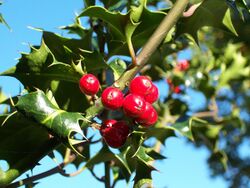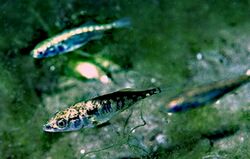Biology:Ecological speciation

Ecological speciation is the process by which ecologically based divergent selection between different environments leads to the creation of reproductive barriers between populations.[1] This is often the result of selection over traits which are genetically correlated to reproductive isolation, thus speciation occurs as a by-product of adaptive divergence.[2][3]
Ecological selection is "the interaction of individuals with their environment during resource acquisition".[4] Natural selection is inherently involved in the process of speciation, whereby, "under ecological speciation, populations in different environments, or populations exploiting different resources, experience contrasting natural selection pressures on the traits that directly or indirectly bring about the evolution of reproductive isolation".[5] Evidence for the role ecology plays in the process of speciation exists. Studies of stickleback populations support ecologically-linked speciation arising as a by-product,[6] alongside numerous studies of parallel speciation—of which, substantiates speciation's occurrence in nature.
The key difference between ecological speciation and other kinds of speciation, is that it is triggered by divergent natural selection among different habitats; as opposed to other kinds of speciation processes, like random genetic drift, the fixation of incompatible mutations in populations experiencing similar selective pressures, or various forms of sexual selection not involving selection on ecologically relevant traits. Ecological speciation can occur either in allopatry, sympatry, or parapatry. The only requirement being that speciation occurs as a result of adaptation to different ecological or micro-ecological conditions.[1]
Some debate exists over the framework concerning the delineation of whether a speciation event is ecological or nonecological. "The pervasive effect of selection suggests that adaptive evolution and speciation are inseparable, casting doubt on whether speciation is ever nonecological".[7]
Parallel speciation
Parallel speciation is where "greater reproductive isolation repeatedly evolves between independent populations adapting to contrasting environments than between independent populations adapting to similar environments".[8] It is established that ecological speciation occurs and with much of the evidence, "...accumulated from top-down studies of adaptation and reproductive isolation".[8]
Research and supporting evidence
Known examples of ecological speciation are three-spined stickleback fishes, distinct species of which emerged as the result of adaptation to different conditions along water depth clines in freshwater lakes.[9] Ancestors of the genus Ilex (holly) became isolated from the remaining Ilex[clarification needed] when the landmass broke up into Gondwana and Laurasia about 82 million years ago, resulting in a physical separation of the groups (allopatry) and beginning its adaptation to new conditions; over time survivor species of the holly genus adapted to different ecological niches. The invasive weed species Centaurea solstitialis is thought to be a case of ecological speciation—in less than 200 years, incipient reproductive isolation appeared as a result of adaptation to differences in ecological conditions between native and non-native ranges.[10][11]
Mosquito fish
Parallel speciation occurs, for example, in mosquito fish in the Bahamas, where Gambusia fish inhabit "blue holes"—carbonate caves and depressions flooded with water—throughout the islands. Some of the holes contain the piscivorous predator fish Gobiomorus dormitor, while others have no major predators except birds. The authors of the study tested for ecological speciation by measuring three different data sets: morphological data (to test for divergent natural selection), molecular data (to test for "replicated trait evolution in independent populations" with similar phenotypes), and mate-choice trials (to test for reproductive isolation between "ecologically divergent pairs of populations than[clarification needed] ecologically similar ones": a by-product resulting from divergent traits). The study allowed for a natural experiment to test the effects of predator-mediated natural selection and its by-product: ecological speciation. The results suggested a "strong confirmation of the ecological speciation hypothesis" and amply supported parallel speciation taking place within the different blue holes.[12]
Skinks
Another example is in skinks, where the genus Plestiodon (formerly Eumeces) has a complex evolutionary history with ecological speciation and parallel speciation of the three species (within two morphotypes): P. skiltonianus and P. lagunensis, and P. gilberti. P. gilberti occupies dry, low-elevation habitats, and has a larger body size and uniform, solid color scales. The other two species inhabit higher-elevation regions, have smaller bodies, and exhibit colored stripes. The members of the group have similar phenotypic stages during early development but differ in their morphology in later stages. A phylogenetic analysis using mtDNA of the entire group (including all species and subspecies of the Eumeces group inhabiting the western United States) combined with comparative approaches to morphology, and geographic distribution showed "instances of parallel morphological evolution...and provide evidence that this system is consistent with a model of ecological speciation" due to "the similarity in early ontogenetic trajectories and the close association between differences in body size and color pattern[s]" of each morphotype.[13]
See also
- Speciation
- Allopatric speciation
- Sympatric speciation
- Parapatric speciation
- Adaptive radiation
- History of speciation
References
- ↑ 1.0 1.1 Nosil, P. (2012). Ecological Speciation. Oxford: Oxford University Press. pp. 280. ISBN 978-0199587117.
- ↑ Mayr, E. (1942). Systematics and the origin of species from the viewpoint of a zoologist. New York: Columbia University Press. pp. 337. ISBN 978-0-674-86250-0.
- ↑ Mayr, E. (1947). "Ecological factors in speciation.". Evolution 1 (4): 263–288. doi:10.2307/2405327.
- ↑ Howard D. Rundle and Patrik Nosil (2005), "Ecological speciation", Ecology Letters 8 (3): 336–352, doi:10.1111/j.1461-0248.2004.00715.x
- ↑ Dolph Schluter (2001), "Ecology and the origin of species", Trends in Ecology and Evolution 16 (7): 372–380, doi:10.1016/S0169-5347(01)02198-X, PMID 11403870
- ↑ Jeffrey S. McKinnon (2004), "Evidence for ecology's role in speciation", Nature 429 (6989): 294–298, doi:10.1038/nature02556, PMID 15152252, Bibcode: 2004Natur.429..294M
- ↑ James M. Sobel (2009), "The Biology of Speciation", Evolution 64 (2): 295–315, doi:10.1111/j.1558-5646.2009.00877.x, PMID 19891628
- ↑ 8.0 8.1 Dolph Schluter (2009), "Evidence for Ecological Speciation and Its Alternative", Science 326 (5915): 737–740, doi:10.1126/science.1160006, PMID 19197053, Bibcode: 2009Sci...323..737S
- ↑ Behm J. E., Ives A. R., Boughman J. W. (2010). "Breakdown in postmating isolation and the collapse of a species pair through hybridization". American Naturalist 175 (1): 11–26. doi:10.1086/648559. PMID 19916869.
- ↑ Montesinos D., Santiago G., Callaway R. M. (2012). "Neo-allopatry and rapid reproductive isolation". The American Naturalist 180 (4): 529–33. doi:10.1086/667585. PMID 22976015. https://digital.csic.es/bitstream/10261/94629/1/neo_allopatry_rapid_reproductive.pdf.
- ↑ Graebner R. C., Callaway R. M., Montesinos D. (2012). "Invasive species grows faster, competes better, and shows greater evolution toward increased seed size and growth than exotic non-invasive congeners". Plant Ecology 213 (4): 545–553. doi:10.1007/s11258-012-0020-x. https://estudogeral.sib.uc.pt/bitstream/10316/81138/1/Graebneretal2012InvasivegrowsfasterPlantEcology.pdf.
- ↑ R. Brian Langerhans (2007), "Ecological Speciation in Gambusia Fishes", Evolution 61 (9): 2054–2074, doi:10.1111/j.1558-5646.2007.00171.x, PMID 17767582
- ↑ Jonathan Q. Richmond & Tod W. Reeder (2002), "Evidence for Parallel Ecological Speciation in Scincid Lizards of the Eumeces skiltonianus Species Group (Squamata: Scincidae)", Evolution 56 (7): 1498–1513, doi:10.1111/j.0014-3820.2002.tb01461.x, PMID 12206249
 |




